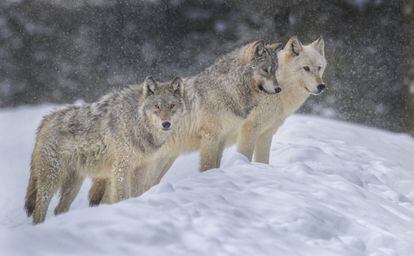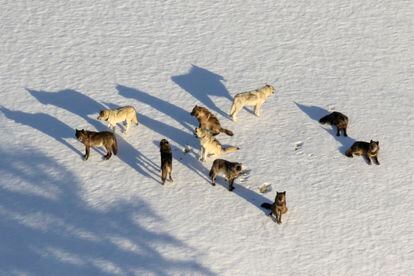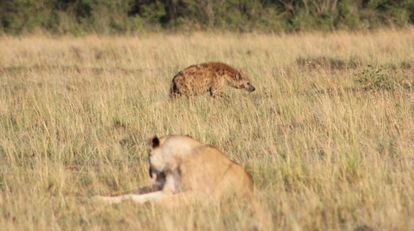Parasite makes wolves bolder, more likely to become pack leaders
A recent study revealed that among the wolves in Yellowstone National Park, those affected by toxoplasmosis usually engage in riskier behaviors

In Yellowstone National Park, in the western United States, wolves infected with Toxoplasma gondii are 46 times more likely to become pack leaders than the healthy ones. At the same time, those affected by toxoplasmosis caused by this parasite tend to engage in riskier behaviors. These patterns, observed over the last 25 years, could be related to the greater or lesser presence of the cougar, the other great predator of the park. Both share their territory and, where the density of cougars is higher, so is the infection by T. gondii among the canines. This parasitic protozoan needs felines to complete its life cycle and, with the help of evolution, it has managed to influence the behavior of large predators such as wolves.
The T. gondii can infect any warm-blooded species, developing cysts in various parts of the body, especially the muscles and brain. Even though it could affect up to a third of humans, it is only dangerous in babies born to infected mothers and people with weakened immune systems. Its life cycle goes through several phases of development, starting in a feline, followed by an external phase that begins in its urine and feces, and requiring intermediate hosts before completing its reproduction again in another feline. This life cycle has caused a strange relationship between infected rodents and cats: several studies have shown that mice or rats with toxoplasmosis are attracted to the smell of cat urine, which makes them vulnerable to being hunted. That way, the T. gondii reaches its final host.
Something similar could be taking place with the great predator of Yellowstone National Park. Every year, the park’s conservationists capture a dozen wolves to perform a complete checkup. They have data for decades and, until 1999, all serological samples were negative for T. gondii. The first cases appeared the following year. In 2020 (the latest year for which data is available) more than 36% of the nearly 250 wolves that were tested had the parasite. The prevalence of toxoplasmosis has also increased among the cougars, affecting more than half of the 62 that were examined. The cause of this rise is not clear, but according to the experts, it could be related to the successful comeback of both species in the park, rather than the introduction of the parasite by other means, such as the domestic cat.

These numbers led park scientists to wonder if, beyond health, the T. gondii was having some kind of impact on animal behavior. With the data accumulated in the last 25 years, they looked for cases of risk behaviors and grouped them into three categories. First, adaptation to human presence; getting closer to people and cars. They also took note of those straying from the pack; like humans, wolves are social animals, and loners have a higher mortality rate. Finally, they observed the disputes over the leadership of the pack. These canines have a very distinct social hierarchy, and the position of leader is won by challenging the current commander.
The results of the study, published in the journal Communications Biology, found no relationship between infection by T. gondii and wolves getting closer to humans. However, they did find that wolves classified as dispersers had nearly twice the T. gondii seroprevalence as those that remained with the pack, 36% for dispersers and 18% for non-dispersers. Even more intriguing: seropositive wolves are up to 46 times more likely to become pack leaders than the seronegative ones. Both these observations fit with a third: the researchers found that the percentage of wolf and cougar territory overlap appeared to be related to disease incidence. While in areas with a low density of felines, the prevalence of toxoplasmosis did not reach 15%, where they abounded, 37% of the canines were infected.
Connor Meyer, a PhD student at the University of Montana, spent several seasons in Yellowstone investigating this peculiar relationship between wolves, parasites and cougars. He explains that wolves do not necessarily avoid cougars, as they pose more of a danger to them than vice versa. If wolves caught a cougar on the ground, he says, they would probably attack and kill it, which could be one way that wolves are getting infected with toxoplasmosis. Or the other way around: the struggle could be a way by which the parasite manages to reach its final host and complete its life cycle.
Meyer and his National Park Service colleagues, who collaborated on the research, are concerned about the impact of these risky behaviors on the pack as a whole. After all, the leaders have a lot to say about how, when and where a pack moves through the territory, he points out, and they could be teaching the uninfected packmates to make riskier decisions. So far, they have not detected an increased mortality rate from causes related to behavior among those infected with Toxoplasma gondii.

Prehistoric remnants
What does the parasite gain by choosing the leader of the pack? In rodents, an almost mechanical relationship between infection and approaching cats – the necessary destination for these protozoa – has been detected. Some studies have observed that infected chimpanzees lose their aversion to leopard urine, which usually warns them that their predator is nearby.
Meyer speculates that, in the Pleistocene, wolves would be further down the food chain and there would still be American lions (they became extinct about 8,000 years ago). If so, we could probably be seeing something similar to what we see in spotted hyenas and African lions, where toxoplasmosis-positive hyena cubs are more likely to approach the lions. The behavioral effects we are seeing now may be remnants of that Pleistocene dynamic.
Meyer’s reference to hyenas alludes to a study published last year that made a fascinating discovery: among hyenas infected as cubs, 100% of the deaths were caused by lions, while only 17% of the deaths of hyenas not infected as cubs were caused by lions. The research, based on three decades of observations of two hundred hyenas from the Masai Mara reserve in Kenya, found that the cubs affected by the parasite were more reckless and engaged in obviously risky practices, such as not keeping their distance from lions. Adult hyenas with toxoplasmosis also tempted their fate more, getting closer to their only great enemy. The result was increased mortality. From 33 cases of dead hyenas with a known cause, those infected were twice as likely to have died from a feline attack. Lions don’t eat hyenas, but when they bite their heads, the T. gondii cysts can enter the lion and the parasite can reproduce again.
Zachary Laubach, an ecologist from the University of Colorado Boulder who participated in the hyena study, notes that although infected cubs did have a higher mortality caused by lions than uninfected cubs, the size of the sample was relatively small. Regarding rank, they did not see a connection between parasite and leadership. The social hierarchy in both species is very different; hyenas inherit their mother’s rank. Additionally, the size of the group is nothing alike. Among wolves, packs number about half a dozen individuals, all related. Among hyenas, clans can include more than 100 adults.
Leaving domestic cats aside, the cases of chimpanzees, wolves and hyenas would explain the survival of the parasite among humans as a legacy of the past. Today, the parasite is linked to a higher incidence of suicide and aggressiveness, but we are no longer a good intermediate host. In the past, however – as the authors of the wolf study point out – humans were also prey to big cats.


/cloudfront-eu-central-1.images.arcpublishing.com/prisa/C25T4ZNJGX27XD62XV2XACVHCM.jpg)










































